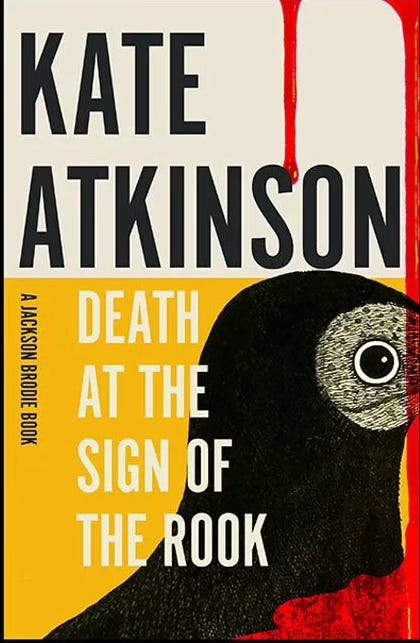Death at the Sign of the Rook by Kate Atkinson
a country house, a snowstorm and a stolen painting: Kate Atkinson does the Golden Age
There are plot spoilers throughout.
“Unless it’s Addison,” the Reverend Smallbones said. “It often is. As a butler, he belongs to a profession that seems to harbor an unusually high number of murderers.”
I’m closing out 2024 with something unusual for The Butler Did It: a recent release. A new Kate Atkinson novel is always good news, and one that riffs on golden age detective fiction feels like an end-of-year gift, so I’m breaking with months-long tradition and taking on a 2024 release: the latest in the Jackson Brodie series, Death at the Sign of the Rook.
As readers of the series know, this isn’t the Golden Age, obviously. Jackson Brodie’s feet are planted firmly in the present (though his thoughts are often mired in his past). He drives a comically large car, the Defender, whiles away his time in coffee shops browsing on the internet and has a Russian sometimes dominatrix quasi-girlfriend. But many of Atkinson’s novels, particularly the ones in the Brodie series, have flirted with the Golden Age. Atkinson often pokes affectionate fun at the absurdities of the genre, most prominently with the character Martin Canning in One Good Turn, who writes cosy mysteries featuring a can-do girl sleuth he has grown to hate.
So it’s delightful, if not surprising, that Atkinson has led Brodie into a Golden Age-inspired romp, taking aim at the most beloved tropes in the genre.
The plot takes off with the theft of a Renaissance-era painting from the home of a recently deceased widow; her noxious children hire Brodie to track down the painting, which they believe was stolen by her carer. He in turn enlists the help of Detective Constable Reggie Chase, a recurring character who first appeared as an orphaned teenager in 2008’s When Will There Be Good News? She recently investigated the theft of a Turner at Burton Makepeace House, the obligatory manor around which the action turns.
There are the usual suspects, but with a twist. The dowager, Lady Milton, mad as a hatter, full of caustic one-liners and resentment for her children, one of whom has turned part of their estate into a hotel, serendipitously (and disastrously) hosting a murder mystery weekend. There is a vicar who has lost his faith as well as his voice, a Major suffering from PTSD from an incident in Afghanistan that lost him his leg, and a ne’er do well son, unpleasant and amoral. And the detective.
Brodie is like a cosy version of the American hard-boiled private eye, with a history of trauma and abuse but a soft marshmallowy interior. He has a “slight working-class chip on his shoulder,”1 follows his own moral code (“You were allowed to hit men—sometimes it was wrong not to—but not women, children or dogs.”) not unlike the one outlined by Chandler in his famous takedown of the English country house mystery, “The Simple Art of Murder.”
He must be, to use a rather weathered phrase, a man of honor—by instinct, by inevitability, without thought of it, and certainly without saying it… He is a relatively poor man, or he would not be a detective at all. He is a common man or he could not go among common people. He has a sense of character, or he would not know his job.
That describes Brodie as well as Sam Spade and Philip Marlowe, but Brodie belongs to this world, where he will rescue damsels in distress (Reggie, a daughter figure to him, gets caught in the storm), allow an alluring thief to escape (“His life had just been saved—that demanded a certain reciprocation.”), and visit a lonely old man who is good at keeping secrets. His moral code many be American hardboiled, but his heart is firmly British cosy, as is the plot of the novel.

The characters converge on Burton Makepeace for the Murder Mystery weekend during a snowstorm, isolating them in its maze-like warren of decaying rooms. Along with the residents of the manor, there are the hotel guests (a retired cardiologist from Idaho and her husband; a couple who received the weekend as a gift and “thought we’d better get it over with”), the actors (a motley crew) and various stragglers, including Brodie and Reggie and an escaped serial murderer (because why not?). As the hopelessly incompetent players enact an insipid mystery in various rooms throughout the manor (“Did Sir Hardwick drink from it [the glass] before collapsing and dying? Who gave the drink to Lord Hardwick?”) the real mysteries are being sorted out in the private rooms of the house. Brodie sits down for a tête-à-tête with the thief while Reggie tangles with the escaped killer.
The characters read books by Nancy Styles, a cosy golden age writer in the style of Christie or Marsh. One of her novels forms the plot for the Murder Mystery Weekend, with it’s director acknowledging, “The Murder Mysteries were set in some mythical pre-war England… where vicars came to tea and jolly girls played tennis and the hierarchy of the class system was firmly in place.” A critique that will sound familiar to fans of the genre, but not a trope Atkinson is intent on maintaining.
More in keeping with the American hardboiled genre, the inciting mystery is still somewhat unresolved at the end - the Renaissance painting reappears but the thief rides off into the sunset, unidentified and unpunished. But the remaining characters, in true cosy style, receive some kind of closure, or at least a measure of peace. Except for Jackson Brodie, eternally in search of his next case.






